Juneberry (Amelanchier alnifolia) notes:
Known by various names as juneberry, saskatoon, serviceberry, shadbush, the Amelanchier species are wonderful shrubs with anti-ageing properties!
Most of the Amelanchier species are to be found wild in Canada and USA. They are remarkably hardy members of the rose family, much cultivated elsewhere for their flowers and colour but really should be grown more for their health benefits. Both the leaves and the fruits can be used. Here I give an overview of this excellent plant family from description and cultivation to harvesting and use.
Flowers coming soon near you!
The juneberry is such a cheerful plant and I look forward to the flowers each spring in our UK cottage garden. These shrubs may often be found as ornamentals in gardens. The flower buds forming right now are gently hairy and delicate. The starlike white flowers follow, often in profusion, and then the leaves. Amelanchier species are mostly slender small trees or large shrubs with smooth grey bark and fragrant white star-like flowers and edible fruits. They are deciduous and grow to 3-5 m high, often multi-stemmed. Although said to flower in May, I have noticed that there are now flowers much earlier in April. The fruits are all edible and ripen early from midsummer (hence the name juneberry!) and quickly disappear as bird food. The fruits are dark red to purple and blackcurrant size, and they may be sweet and juicy, though some kinds are rather bland to taste.
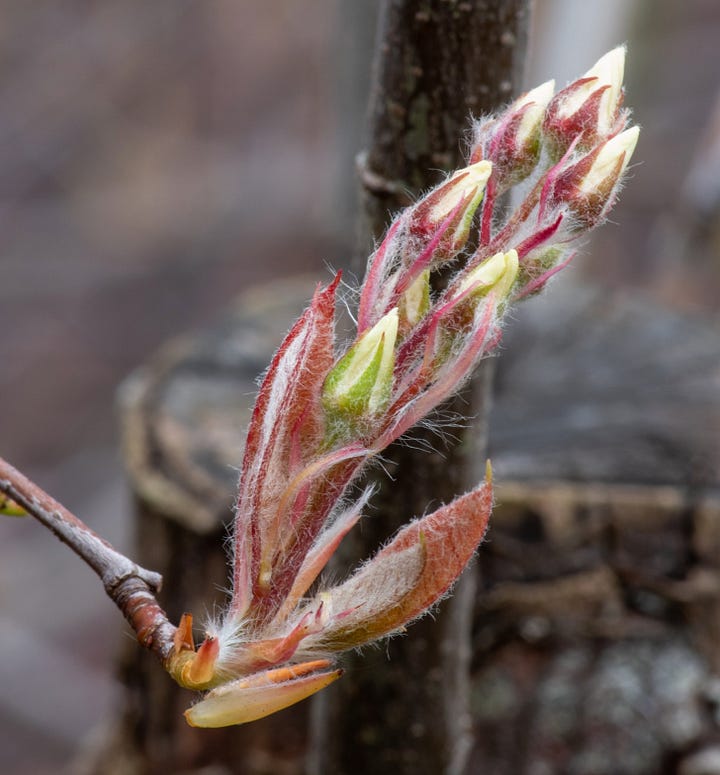

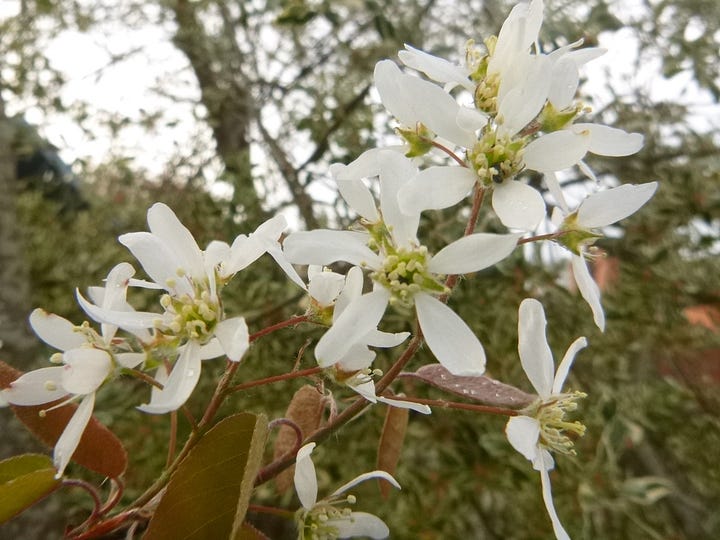
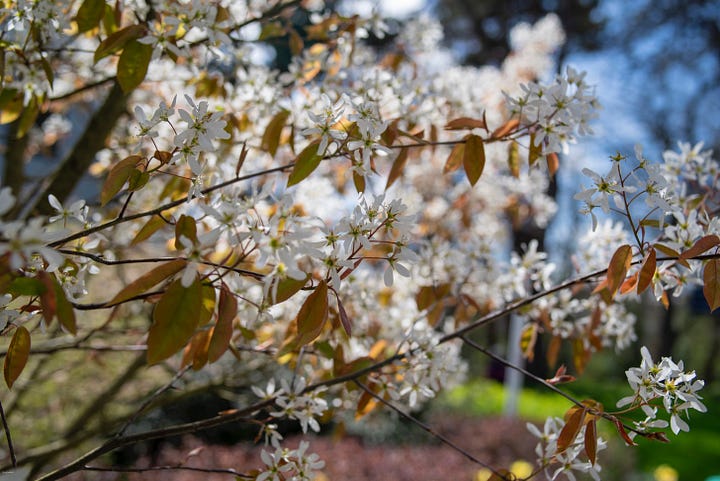
Which one is which?
Many Amelanchier species naturally grow in thickets and stream edges in North America. There are several dozen related species including the Canadian serviceberry (A. canadensis) and a smaller shrubby version (A. stolonifera). There is often hybridisation too between the species. Telling the species apart is not so easy, for most the leaves are simply green and oval with finely serrated edges. In the native plants, the differences are likely to do with the habitat. Some of the species differ in the leaf colour when opening out, the hairiness of the leaves, and some have more or less tasty fruits. I would like to track down Amelanchier ovalis, known as 'snowy mespilus' and reported as a dwarf mountain shrub that does well in limey soils, and is found as a native in various parts of Europe or Asia (Asyakina et al., 2022). I suspect that the juneberry growing in our garden is Amelanchier canadensis, also known as Canadian serviceberry, I should have written the name down somewhere when planting. Or perhaps it could be Amelanchier lamarckii, widely sold in UK garden centres, and also called snowy mespilus. It gets quite confusing trying to work out which one is which!
What is the use of juneberry?
The juneberry is a rose family member and hence rich in tannins. Medicinal herbal actions of the Amelanchier species include astringent, anti-oxidant, antiseptic, digestive tonic, benefits of both the leaves and berries. Traditional use in northern America has been widely reported for most parts of the shrubs for a variety of complaints, such as the juice for treating stomach ailments and as a laxative, and the berries for eye and ear drops. The bark was boiled as a disinfectant and a tea of the twigs was given to women after birth to assist placental discharge. A root bark tea was used for excessive menstrual bleeding as well as diarrhoea. The fruits were used in pies and formed part of pemmican dried food.
Indications and research
Studies of the varieties have identified significant anti-oxidant and hypoglycaemic activity with potential for use in diabetes since polyphenols can help to reduce blood glucose levels (Zhao et al., 2020). More research is needed. No contra-indications are known though it is likely that excessive consumption of the seeds is ill-advised, similarly to apple pips. Consumption of the fruit will help energy levels and boost immunity, and provide anti-inflammatory and anti-oxidant effects to combat ageing.
Cultivation and potential commercial use
The juneberries are remarkably hardy and can be grown in a range of places from mountains to almost sub-Arctic conditions. Generally, they prefer to grow in full sun though do tolerate light shade. A well-drained but moist soil is ideal, and the juneberry is able to grow in most kinds of soil. The plant is self-fertile. The juneberry can be pruned to remove older branches, this is best done after flowering in later spring. Bear in mind that flowers and fruit are borne on the previous year's growth. In commercial production the plants may be cut back to 2-3 m in height and the centre branches are regularly thinned. There is potential for more cultivation of juneberries (Donno et al., 2016).
Active constituents and harvesting
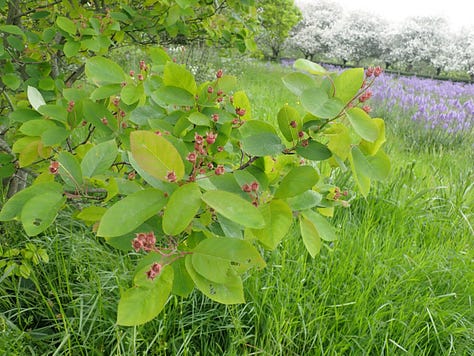
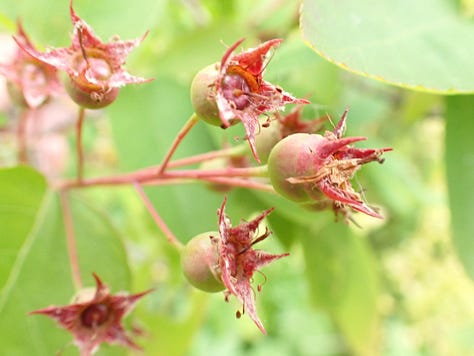
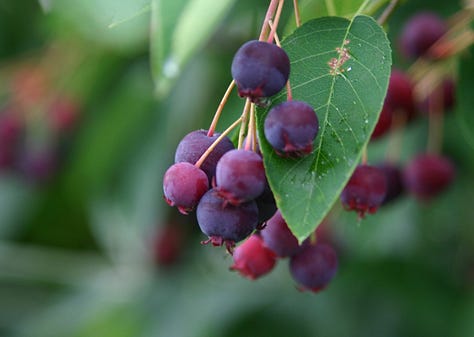
The fruits are a good source of minerals, anthocyanins and flavonoids with anti-oxidant effects. The phenolic constituents hold up well in various preparations from Amelanchier species (Mikulic-Petkovsek et al., 2020). Young leaves with astringent properties can be picked in spring and early summer and used fresh or dried. The leaves can be used as a tea substitute, ideal as a spring tonic tea. The ripe fruit is likely to be taken by birds in autumn and may need protection. It should be picked as soon as ripe and can be frozen or dried. The purplish fruit has a sweet almond-like flavour which can be used in berry tea blends, the dried berries are steeped in boiling water for 5 min.
Recipes for juneberries
The fruits can be eaten fresh, added to muesli, infused in apple cider vinegar, added to pies. There are quite a few online recipes for use of the berries. You can make a sauce by stewing the berries with a little water and adding lemon juice and sugar to taste.
RECIPE FOR A JUNEBERRY SHRUB
300 g ripe juneberries
250 ml wine vinegar
sugar
Crush the berries and place in a glass jar with the vinegar. Cover and allow to steep for four weeks, stirring daily. Then strain the fruit off. Add 150 g sugar per 300 ml liquid. Heat in a pan until the sugar dissolves, then allow to cool, bottle and label. Store in refrigerator 12-14 days. Dilute with sparkling water to serve as a refreshing tonic. (Recipe extract from Trees and Shrubs That Heal)
Further uses
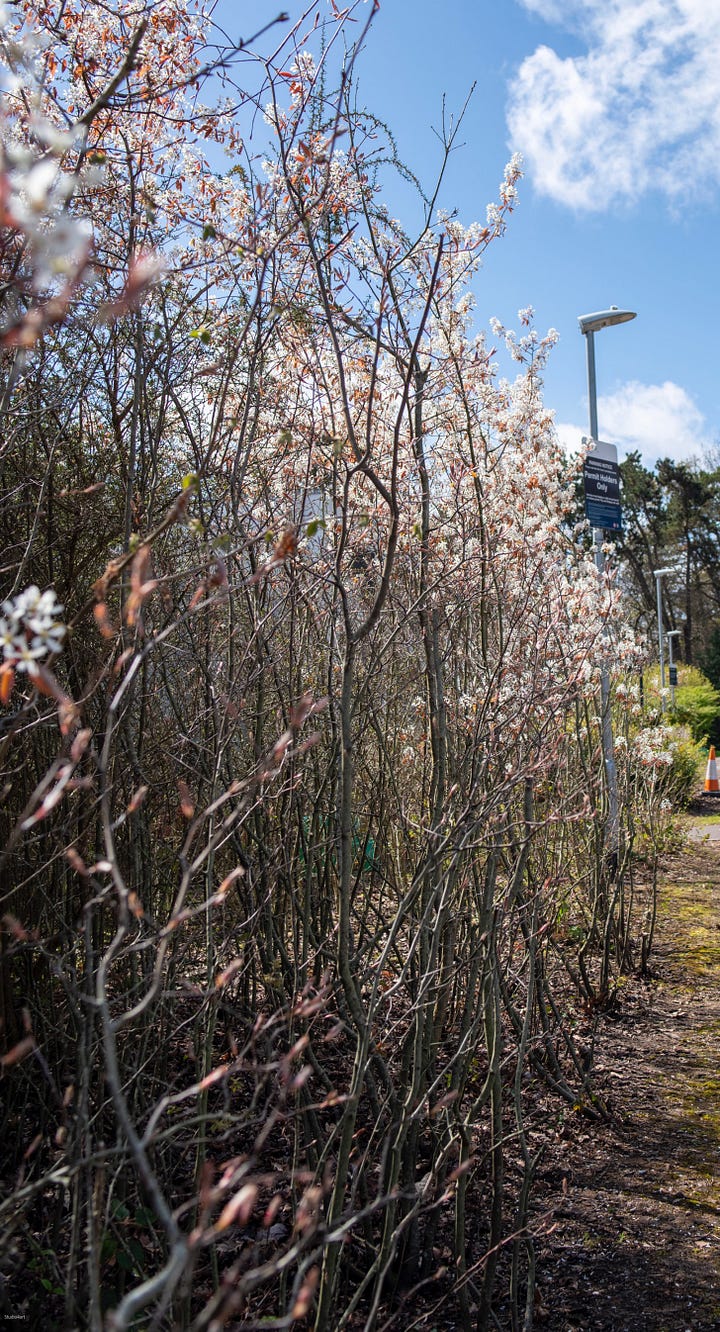
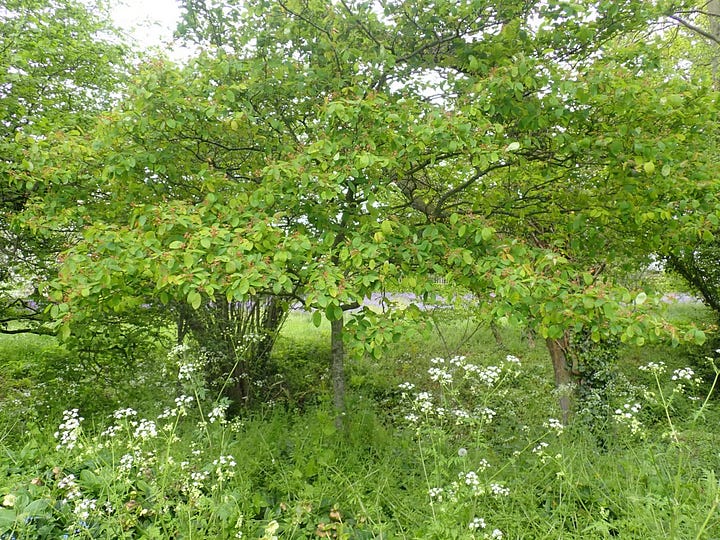
The juneberry could be considered for making a good-sized hedge. Pruning will likely be needed to manage this. A shrub will produce suckers and develop into a thicket if unmanaged. This is a great plant for biodiversity as it offers early spring flowering for bees and other pollinators. The edible fruit is also very much liked by birds. Amelanchier species are quite ornamental and there are some varieties sold mainly for the showy white flowers and autumn leaf colour. There are numerous varieties available, Amelanchier alnifolia 'Obelisk' is an upright variety with larger berries.
Suppliers of note of young and affordable plants either for hedging or for improved fruiting varieties include:
Ashridge trees in UK
Future Forests in Ireland
GrimoNut Nursery in Ontario, Canada
Coldstream Farm in Michigan, USA
Conclusion
I guess you could be rushing out to buy some of these fabulous juneberries without delay! It is almost too late for planting trees as the warmer weather can encourage growth without full root establishment but is possible if you take care to water well through the first year. Alternatively, you could pot up plants and bring them on for planting in a subsequent year. You can see more fantastic examples of medicinal plants like this in my book Trees and Shrubs That Heal that contains 80 detailed profiles with recipes (published late 2023 and available from all good booksellers).
References
Asyakina L, Atuchin V, and Prosekov A. 2022. Ex vivo and in vitro antiaging and antioxidant extract activity of the Amelanchier ovalis from Siberia. Int J Mol Sci 23: 151-156.
Donno D, Cerutti AK, Mellano MG, Prgomet Z, and Beccaro GL. 2016. Serviceberry, a berry fruit with growing interest of industry: Physicochemical and quali-quantitative health-related compound characterisation. J Funct Foods 26: 157-166. DOI: 10.1016/j.jff.2016.07.014.
Mikulic-Petkovsek M, Koron D, and Rusjan D. 2020. The impact of food processing on the phenolic content in products made from juneberry (Amelanchier lamarckii) fruits. J Food Sci 85: 386-393. DOI: 10.1111/1750-3841.
Zhao L, Huang F, Hui AL, and Shen GX. 2020. Bioactive components and health benefits of Saskatoon berry. J Diabetes Res 2020: 3901636. DOI: 10.1155/2020/3901636.
I leave you with a video short of the pollarded juneberry in our cottage garden.


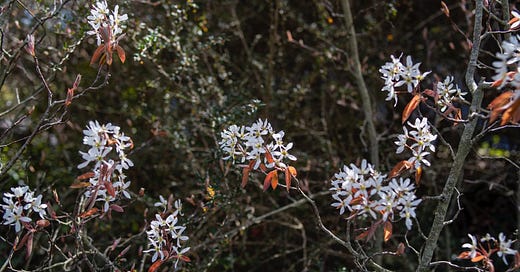



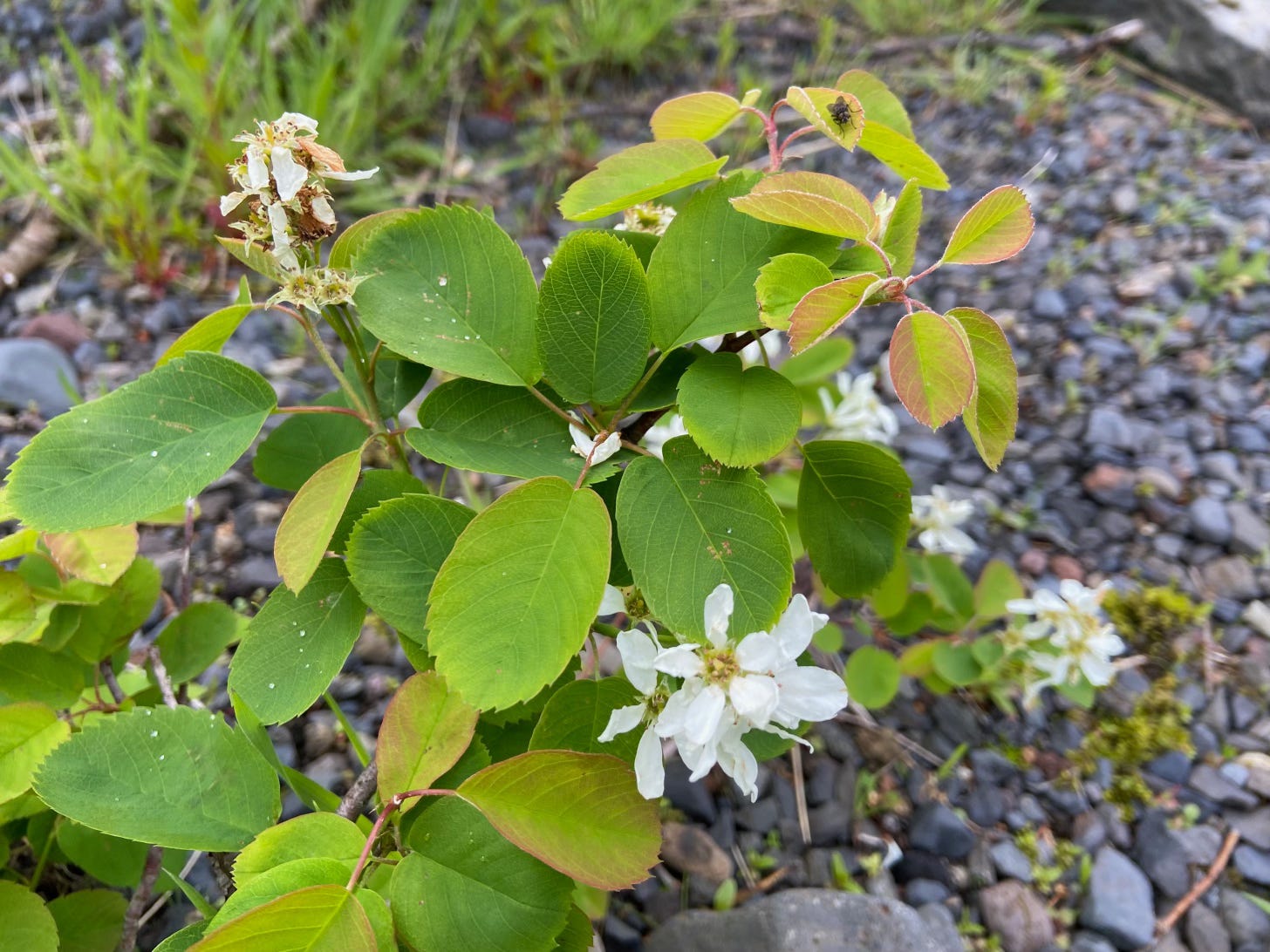
Hi Canda, an ornamental herb garden sounds great! According to Martin Crawford’s UK website at Agroforestry Research Trust you could expect an Amelanchier to reach 3 m or so in 10 years. Some species will continue up to 5 m or so if left unchecked. The ’Obelisk’ variety is tall and slim so would cast less shade on other plants. So that is medium fast growth, I have pollarded ours at about 1.5 m and one branch is forming a main stem (see the video clip at the end of my post) so will need some further pruning! Most descriptions of Amelanchier species refer to it as multistemmed, probably because it can produce suckers, alternatively you could pollard lower down once a plant has established. If you want fruit then check out the Agroforestry Research Trust as they have some excellent cultivars!
Interesting article, thank you. And timely as a multistemmed amelanchier is on of the plants I’m considering for an ornamental herb garden. Can you tell me if they are fast growers. Also, am I right in assuming a multi stem form would be shorter than a tree form - I’m hoping for not more than 3 metres. Thank you again